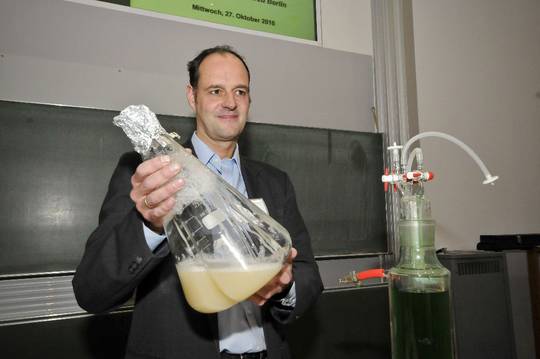Structure of a microbial hydrogen engine
October 21th, 2011
New results on biological hydrogen conversion published in Nature by UniCat researchers
Molecular hydrogen is discussed as promising renewable energy source and attractive alternative to fossil fuels. Many microorganisms exploit the beneficial properties of hydrogen already since more than two billion years. They accommodate dedicated enzymes that either split or evolve molecular hydrogen according to the specific metabolic requirements of the cell.
These hydrogen-converting biocatalysts are called hydrogenases and occur in nature in different varieties. Most hydrogenases become inactivated or even destroyed in the presence of molecular oxygen. This intrinsic property represents a serious problem regarding biotechnological application. However, some hydrogenases maintain their catalytic activity in the presence of oxygen.
An interdisciplinary team of scientists headed by the UniCat researchers Oliver Lenz and Bärbel Friedrich from Humboldt-Universitaet zu Berlin and Patrick Scheerer and Christian Spahn from Charité - Universitätsmedizin Berlin now succeeded in solving the first X-ray crystal structure of a hydrogenase that produces hydrogen even at atmospheric oxygen concentration.
The X-ray crystal structure allows detailed insights into the three-dimensional architecture of the enzyme and its metal cofactors which participate in catalysis. The results have been published in Nature online (http://dx.doi.org/10.1038/nature10505). Interestingly, the hydrogenase contains a novel iron-sulfur center which acts as an electronic switch in the course of detoxification of detrimental oxygen. With this discovery, the scientists could substantiate the hypothesis that this particular group of hydrogenases is able to convert both, hydrogen and oxygen in a catalytic manner. During catalysis, oxygen becomes reduced to harmless water.
The new results are particularly relevant for fundamental research. Moreover, also the biotechnological application of hydrogenases, e.g. solar-driven hydrogen production by photosynthetic microorganisms and enzyme-driven biological fuel cells, may profit from the new findings. Furthermore, it is anticipated that the novel iron-sulfur center will inspire chemists to design model compounds with improved catalytic properties.
UniCat
“Unifying Concepts in Catalysis” (UniCat) is the Cluster of Excellence within the framework of the German Initiative for Excellence researching the economically important field of catalysis. More than 250 chemists, physicists, biologists and engineers from four universities and two Max Planck research institutes from Berlin and Potsdam are involved in this interdisciplinary research network. The Cluster is hosted by the Technische Universität Berlin. The subject areas covered range from the chemical conversion of natural and biogas, the activation of carbon dioxide and the creation of hydrogen from light and water, to the synthesis of active ingredients using enzymes.
For further information please contact:
Dr. Oliver Lenz, Institut für Biologie / Mikrobiologie der Humboldt-Universität zu Berlin, Germany, Phone: +49 (0) 30 2093 8173, E-mail: oliver.lenz(at)cms.hu-berlin.de
Dr. Martin Penno, Public Relations, UniCat Cluster of Excellence, Phone: +49 (0) 30/314-28 592, E-Mail: martin.penno(at)tu-berlin.de
Published in: Fritsch, J., P. Scheerer, S. Frielingsdorf, S. Kroschinsky, B. Friedrich, O. Lenz & C. M. Spahn. The crystal structure of an oxygen-tolerant hydrogenase uncovers a novel iron-sulphur centre. Nature doi: 10.1038/nature10505 (2011)
dx.doi.org/10.1038/nature10505
Media information for download:
www.pressestelle.tu-berlin.de/medieninformationen/
“IN-sights for journalists” – Services provided by the TU Berlin for media representatives: history of research, expert services, idea pool, photo galleries at: http://www.pressestelle.tu-berlin.de/?id=4608

